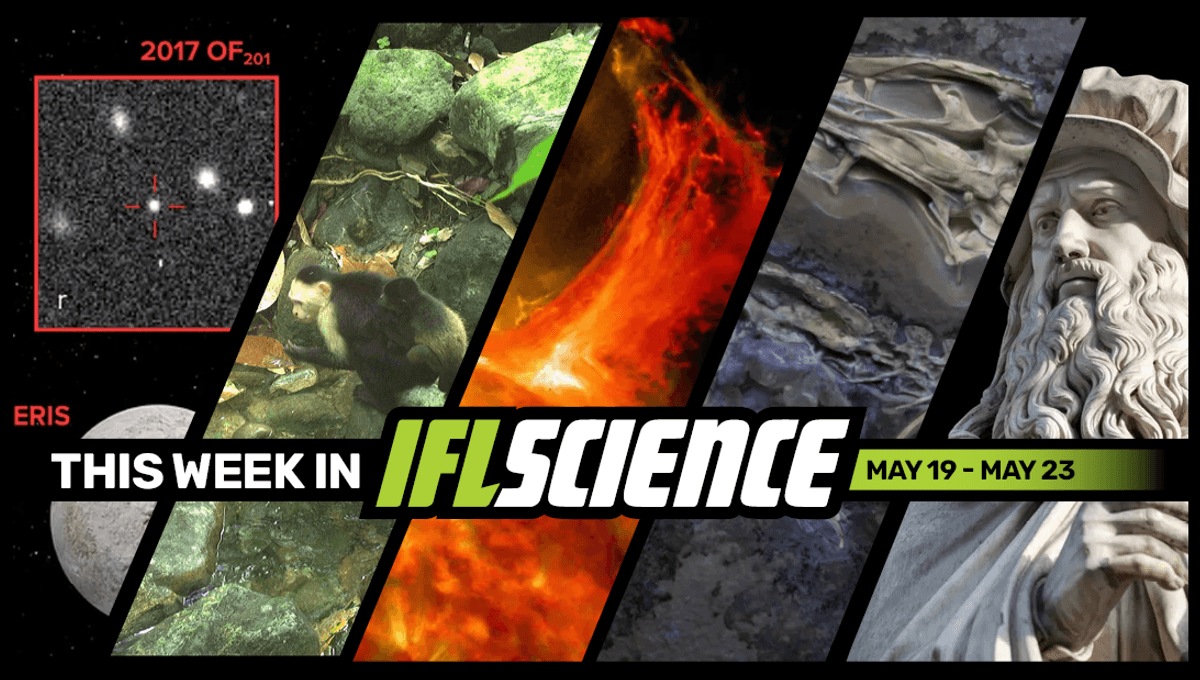
This week, the US ran a solar storm emergency drill and it turns out we’re woefully unprepared, a fluorescent Archaeopteryx changed our understanding of the evolution of flight, and a new book claims to have identified six living relatives of Leonardo Da Vinci using DNA. Finally, the BBC’s Walking With Dinosaurs is back, and we had an exclusive chat with some of the experts behind the series.
Create an IFLScience account to get all the biggest science news delivered straight to your inbox every Wednesday and Saturday.
Newest Member Of The Solar System Just Announced – And It’s In An Extreme Orbit
The Solar System has just gotten a new official member. Currently, with the name of 2017 OF201, this is a trans-Neptunian object (TNO). This means that it orbits the Sun further away than Neptune. Actually, its orbit is so big that it takes about 25,000 years to complete. Read the full story here
Stealing Baby Howler Monkeys Is Suddenly All The Rage Among Capuchins On Jicarón Island
White-faced capuchin monkeys on Jicarón Island have started abducting baby howler monkeys, surprised scientists report. It’s possible this behavior comes in waves, but it had not been detected in the first five years scientists intensively studied the population, and now appears to be spreading widely. The reasons are still unknown, but the authors think adolescent male boredom may be at the heart of it. Read the full story here
The US Ran A Solar Storm Emergency Drill And It Suggested The Real Thing Would Be Catastrophic
Researchers from a bunch of US government agencies recently published the results of the first-ever “Space Weather Tabletop Exercise” to assess their preparedness for a severe solar storm. It turns out, we’re woefully unprepared for such an event. Read the full story here
“Under UV Light, The Bone Glows Brightly”: A Fluorescent Archaeopteryx Just Changed Our Understanding Of The Evolution Of Flight
The Chicago Archaeopteryx is a remarkable fossil, the “best preserved” of its kind, in fact. That’s according to palaeontologist Prof Jingmai O’Connor, who’s something of an expert in the transition that saw theropods morph into birds. Now, never-before-seen Archaeopteryx feathers suggest it could fly, changing what we know about how flight evolved. Read the full story here
Six Living Relatives Of Leonardo Da Vinci Have Been Identified Using DNA, Claims New Book
Leonardo da Vinci – the artist, scientist, and archetypal polymath of the Renaissance – may still have descendants living among us. In a new book, researchers from the Leonardo DNA Project have put together the clearest view yet of the late genius’s family tree, suggesting that the da Vinci male lineage has remained genetically unbroken for at least 15 generations. Read the full story here
TWIS is published weekly on our Linkedin page, join us there for even more content.
Feature of the week:
The Longest Predatory Dinosaur Known To Science Was Probably A Great Dad, Too
Just over 90 million years ago, a prehistoric giant went extinct. Longer than Tyrannosaurus rex, and considerably taller, Spinosaurus was one of the largest theropod dinosaurs ever to stomp across the planet, but unless you count that time we heard a ringtone coming out of one’s belly in Jurassic Park III, we’ve never really got to properly appreciate what these things would’ve looked like alive. Well, that’s all about to change. Read the full story here
More content:
Have you seen our e-magazine, CURIOUS? Issue 34, May 2025, is available now. This month we asked, “Why Do We Love Nostalgia?” – check it out for exclusive interviews, book excerpts, long reads, and more.
PLUS, the We Have Questions podcast – an audio version of our coveted CURIOUS e-magazine column – continues. In episode 8, we ask, “What Happens To Eyes During The Mummification Process?”
The Big Questions podcast returns next month for season 5. Catch up with all past episodes here.
Source Link: Newest Member Of The Solar System Just Announced, Capuchins Have Started Stealing Baby Howler Monkeys, And Much More This Week